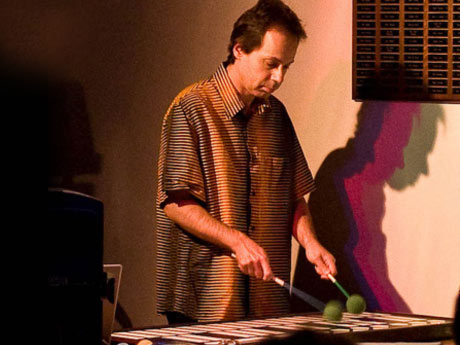Photo by Werner Puntigam
You’ve spoken about the importance of dance and the body in African music.1 Can you say more?
LL: Perhaps I have been thoroughly Africanized, but I always see music and dance as essentially the same thing, even if there is a reversal of cause and effect: a musician moves (on the instrument) and thus creates sound; a dancer reacts to sound to create movement. After all, even a rendition of a highly abstract, modernist piece for, say, bass flute is the result of the motion of the flutist's mouth and fingers; therefore, I maintain that any music can be danced to, if one knows the key, the secret code, to understanding it and hearing it in a way that it becomes danceable. I went to a village in Zimbabwe to listen to musicians of the Batonka tribe play their Ngoma Buntibe funeral music tradition; I could not hear any clear rhythmic structure in the music, but they were dancing. I think people generally tend not to be free enough in their thinking. Why is it necessary to hear a beat in order to dance?
Download Video:
MP4,
Ogg
HTML5 Video Player by VideoJS
Solo concert at CS 13 in Cincinnati, OH performing "Entering:Perceiving Masks; Exiting: Perceiving Faces"
In your article, ‘Secret Instruments, Secret Destinations,’ you wrote, “...I see many things about African culture that make it especially well-suited for electronic experimentation.” You went on to say, “In many African languages the words for “playing” and “dancing” music are identical. Electronic music has introduced an unprecedented detachment between motion and sound into music-making. Audiences can’t follow most electronic performers’ movements, not to mention connect them with the sounds they are hearing...” A contradiction?

Photo by Daniel Sofer
It is not a contradiction. Many musicians working with electronics don't seem to be interested in the movement of the player’s body and electronic music detaches the production of sound from physical motion. I have always found the experience of watching laptop performance a bit disappointing, not only because I don't see the performer move, but also because I don't see any relationship between the little movement I do see and the sounds I hear. Since African music is strongly related to movement and to dance, and since some performance practices in Africa base instrumental performance more on motion patterns than on pitch, for example, I think Africa holds a huge potential for the development of new types of electronic music performance, in which the performer's motion is directly connected with the music.
There are many reasons why I believe it makes sense to work with electronics in Africa. Much (though not all) African music is based on a fast underlying pulse, often implied rather than played. Any given pulse "unit" can be played or not played, analogous to a 1 or a 0 in a computer. In a certain respect, this music is already digital even when electronics are not used. Furthermore, since much commercial music software was written mainly with Western pop songwriting in mind, and since certain principles of African music are fundamental to Western pop music, many aspects of such programs are particularly conducive to African approaches to rhythm (again, because of its "digital" nature) and form (because of the easy manipulation of cyclical structures).
Download Video:
MP4,
Ogg
HTML5 Video Player by VideoJS
Excerpt 1 of 2 from Lukas Ligeti's "Kaleidoscope Point" performed at the Whitney Museum, New York City. Performed by Dan Blake (saxophones), Eyal Maoz and Wende K. Blass (guitars), Lorna Krier (synthesizer), and Lukas Ligeti (drums).
Another area to consider is that of timbre: in Western classical music, the sonic ideal is one of purity, whereas in Africa, sympathetic vibrations and mirlitone effects are often desirable. Computers offer many ways of sound processing, of making an initial signal "impure". While in the West instrumental sounds tend to be largely standardized — a violin in Portugal ideally sounds the same as in Finland — this is not the case at all in Africa, where, moving from village to village, instrument builders work differently and instruments are standardized neither timbrally nor in tuning nor in construction technique. The realm of electronic music is also one of non-standardization; when looking at another electronic musician's computer screen, it is usually difficult for me to tell what is going on. In Africa every musician is, one way or another, his own instrument builder. Many, if not most, traditional musicians build their own instruments.
Download Video:
MP4,
Ogg
HTML5 Video Player by VideoJS
Excerpt 2 of 2 from Lukas Ligeti's "Kaleidoscope Point" performed at the Whitney Museum, New York City. Performed by Dan Blake (saxophones), Eyal Maoz and Wende K. Blass (guitars), Lorna Krier (synthesizer), and Lukas Ligeti (drums).
Computers facilitate the combination of media, and in Africa, music and other types of art — not only dance but also visual art, etc. — are closely related. There are many analogies between the way African traditional music deals with rhythmic or pitch patterns, and visual patterns, for example in textile design. And, of course, there’s language: in many forms of African music, even if played instrumentally, some lyrical information underlies the music and often serves as a mnemonic for the musicians, much like notation in the West.
I think African culture could contribute a huge amount to electronic and intermedia art. To me, this is an area of great potential, the surface of which has barely been scratched.